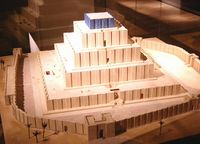Difference between revisions of "Ziggurat"
(not a redirect anymore.) |
(→Origin of the name: Found the oldest apparent reference to "ziggurat", with the help of Halladba) |
||
| (5 intermediate revisions by the same user not shown) | |||
| Line 1: | Line 1: | ||
| − | [[ | + | The '''ziggurat''', also known as '''edge template III1-a''' or '''template 4-3-2''', is a 3rd row [[edge template]] with one stone. |
| − | + | <hexboard size="3x4" | |
| + | visible="area(a3,d3,d1,c1)" | ||
| + | edges="bottom" | ||
| + | coords="none" | ||
| + | contents="R c1" | ||
| + | /> | ||
| − | + | It is one of the most basic non-trivial edge templates. The [[carrier]] is very small so this template occurs in real games quite often. The small size of the carrier makes it efficient as a threat of [[template reduction]] when building other templates. It also appears sometimes in the middle of the board as an [[interior template]]. | |
| − | < | + | |
| − | + | This ziggurat can be used to prove very easily that a move in the center of a size 5 board is winning. | |
| − | + | <hexboard size="5x5" | |
| − | + | coords="hide" | |
| − | + | contents="R c3 S blue:area(c3,e1,b1,b3) red:area(c3,a5,d5,d3)" | |
| − | + | /> | |
| − | </ | + | |
| + | == Defending the ziggurat == | ||
| + | |||
| + | Red has two main threats by playing at "A" or "B": | ||
| + | <hexboard size="3x4" | ||
| + | coords="hide" | ||
| + | edges="bottom" | ||
| + | visible="area(a3,d3,d1,c1)" | ||
| + | contents="R c1 R A:b2 S a3 b3 c1 b2" | ||
| + | /> | ||
| + | <hexboard size="3x4" | ||
| + | coords="hide" | ||
| + | edges="bottom" | ||
| + | visible="area(a3,d3,d1,c1)" | ||
| + | contents="R c1 R B:d2 S c1 d1 c2 d2 c3 d3" | ||
| + | /> | ||
| + | These moves lead to easy direct connection. Because there is no common empty [[hex (board element)|hex]] used in both threats, Blue cannot prevent Red from connecting to the bottom. | ||
| + | |||
| + | == Origin of the name == | ||
| + | |||
| + | [[File:Chogha_Zanbil,_Ziggurat_(model).jpg|right|200px]] | ||
| + | A ziggurat is a type of flat-topped pyramid built in ancient Mesopotamia. The use of this name for the Hex template was apparently coined by Kevin O'Gorman in a post to this [https://littlegolem.net/jsp/forum/topic2.jsp?forum=50&topic=48 Little Golem thread] on October 2, 2003. Incidentally it is the very same thread in which the creation of this HexWiki was proposed. O'Gorman wrote: | ||
| + | |||
| + | ''"So here are two names for consideration. We already have the “2-bridge”, immortalized by Cameron. I think the next most common and useful one is the “temple” (I actually call it the “ziggurat” but that may be asking too much) [...]. The shape reminds me of a mesoamerican temple."'' | ||
== See also == | == See also == | ||
| − | *Some [[puzzles]] directly involve the ziggurat! | + | * Some [[puzzles]] directly involve the ziggurat! |
| − | + | * [[Edge templates everybody should know]] | |
| − | *[[Edge templates everybody should know]] | + | * [[Edge templates with one stone]] |
| − | *[[Edge templates with one stone]] | + | * [[Multiple threats]] |
[[category:edge templates]] | [[category:edge templates]] | ||
[[category:Basic Strategy]] | [[category:Basic Strategy]] | ||
Latest revision as of 07:16, 11 February 2022
The ziggurat, also known as edge template III1-a or template 4-3-2, is a 3rd row edge template with one stone.
It is one of the most basic non-trivial edge templates. The carrier is very small so this template occurs in real games quite often. The small size of the carrier makes it efficient as a threat of template reduction when building other templates. It also appears sometimes in the middle of the board as an interior template.
This ziggurat can be used to prove very easily that a move in the center of a size 5 board is winning.
Defending the ziggurat
Red has two main threats by playing at "A" or "B":
These moves lead to easy direct connection. Because there is no common empty hex used in both threats, Blue cannot prevent Red from connecting to the bottom.
Origin of the name
A ziggurat is a type of flat-topped pyramid built in ancient Mesopotamia. The use of this name for the Hex template was apparently coined by Kevin O'Gorman in a post to this Little Golem thread on October 2, 2003. Incidentally it is the very same thread in which the creation of this HexWiki was proposed. O'Gorman wrote:
"So here are two names for consideration. We already have the “2-bridge”, immortalized by Cameron. I think the next most common and useful one is the “temple” (I actually call it the “ziggurat” but that may be asking too much) [...]. The shape reminds me of a mesoamerican temple."
See also
- Some puzzles directly involve the ziggurat!
- Edge templates everybody should know
- Edge templates with one stone
- Multiple threats
